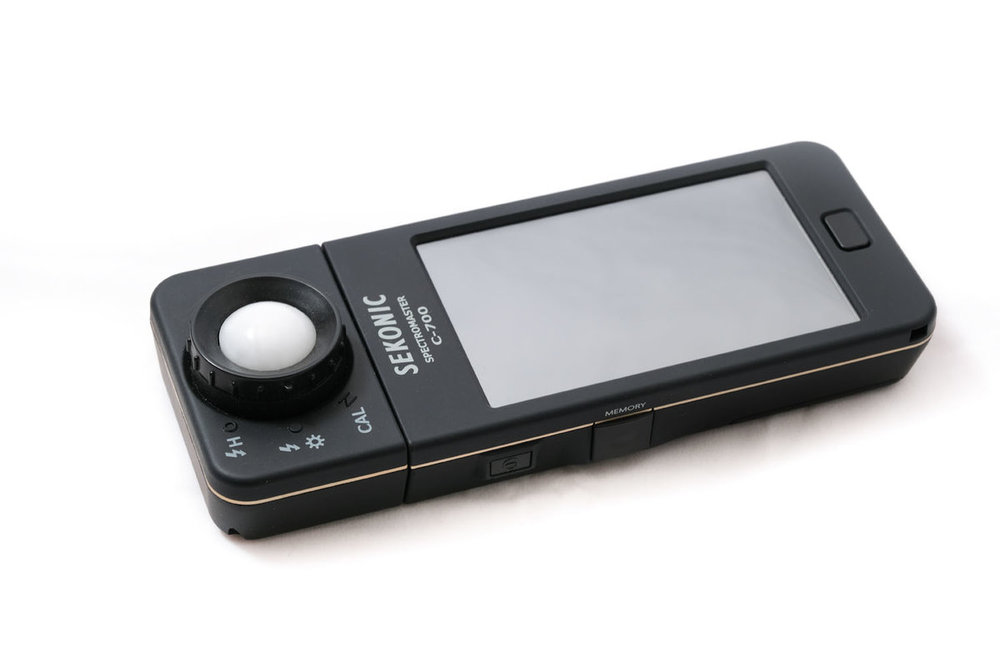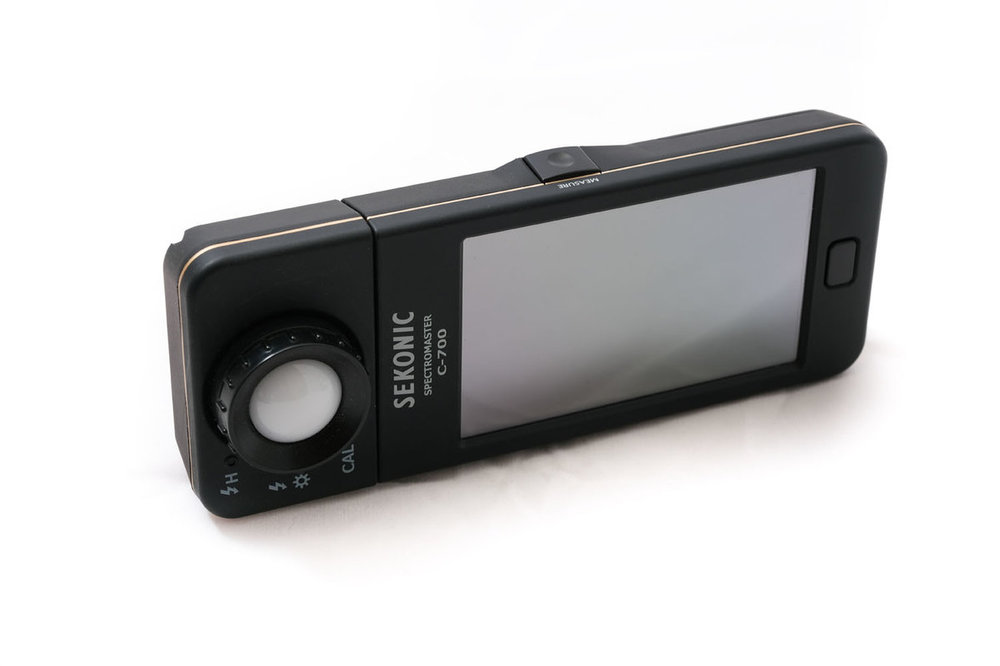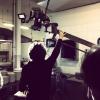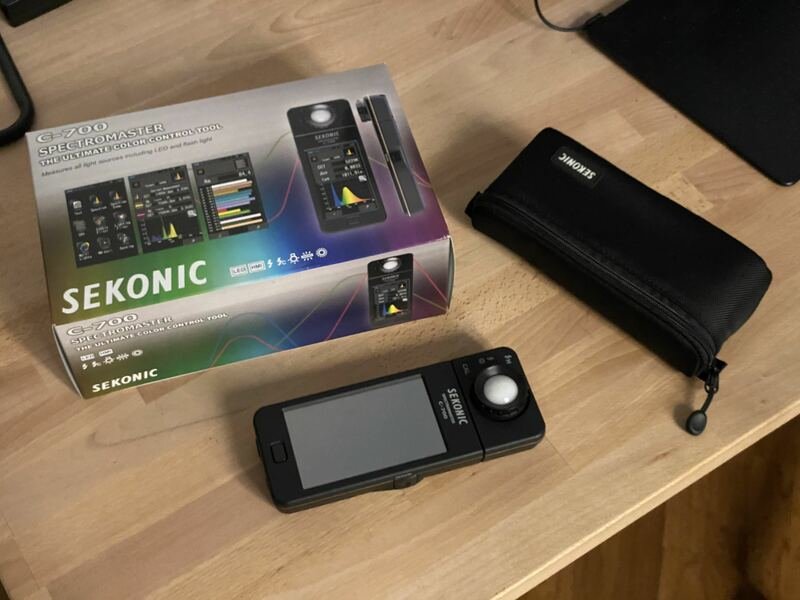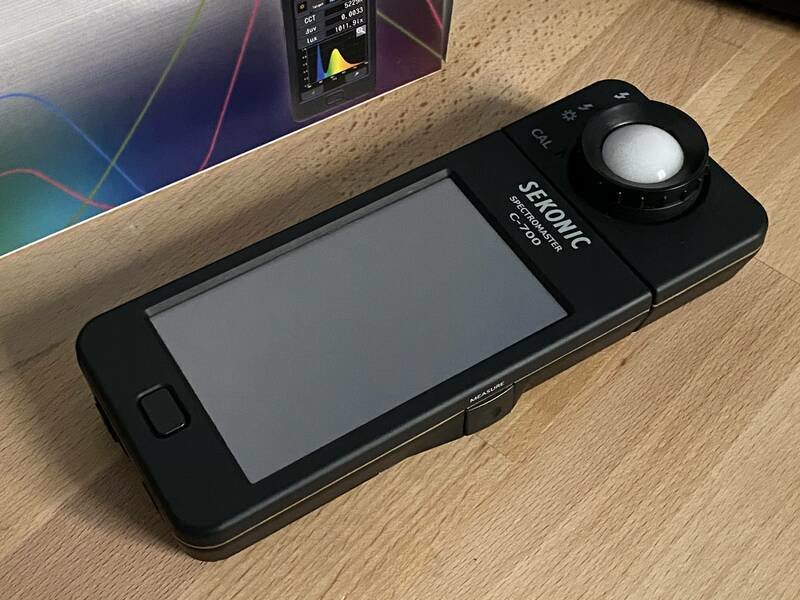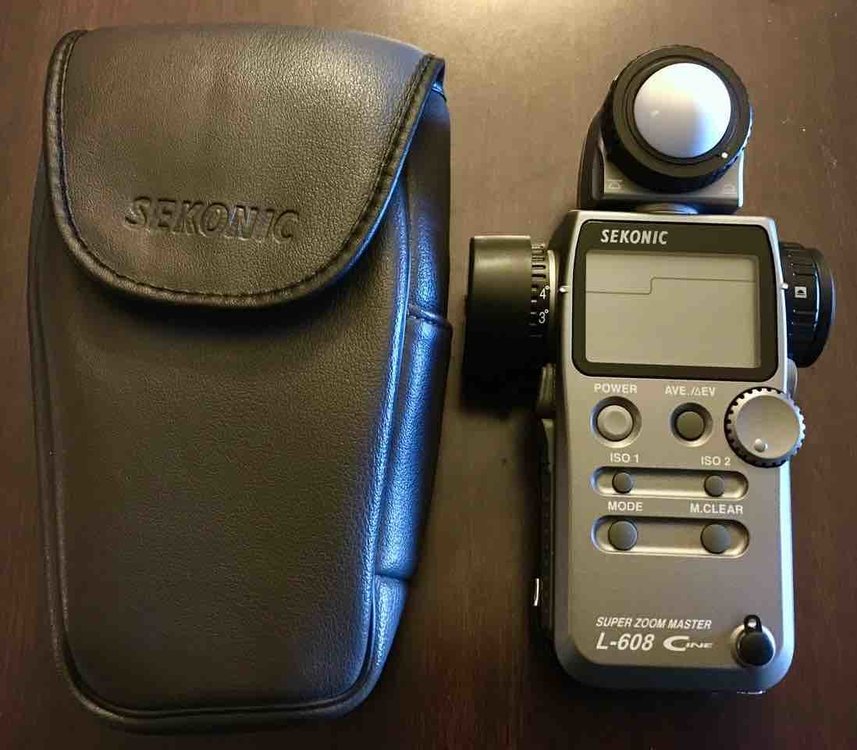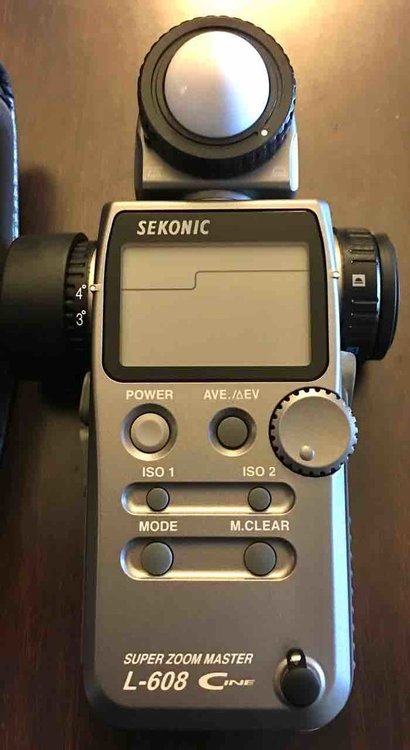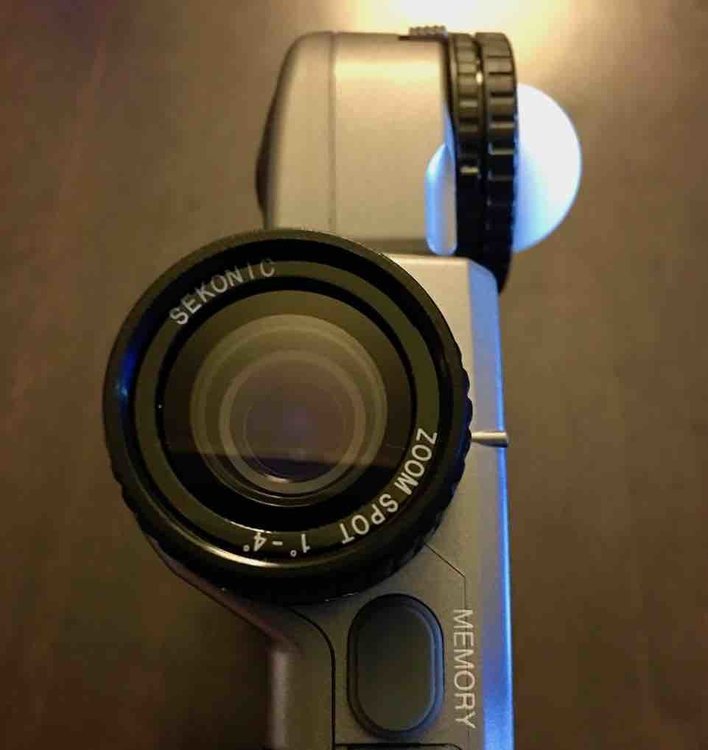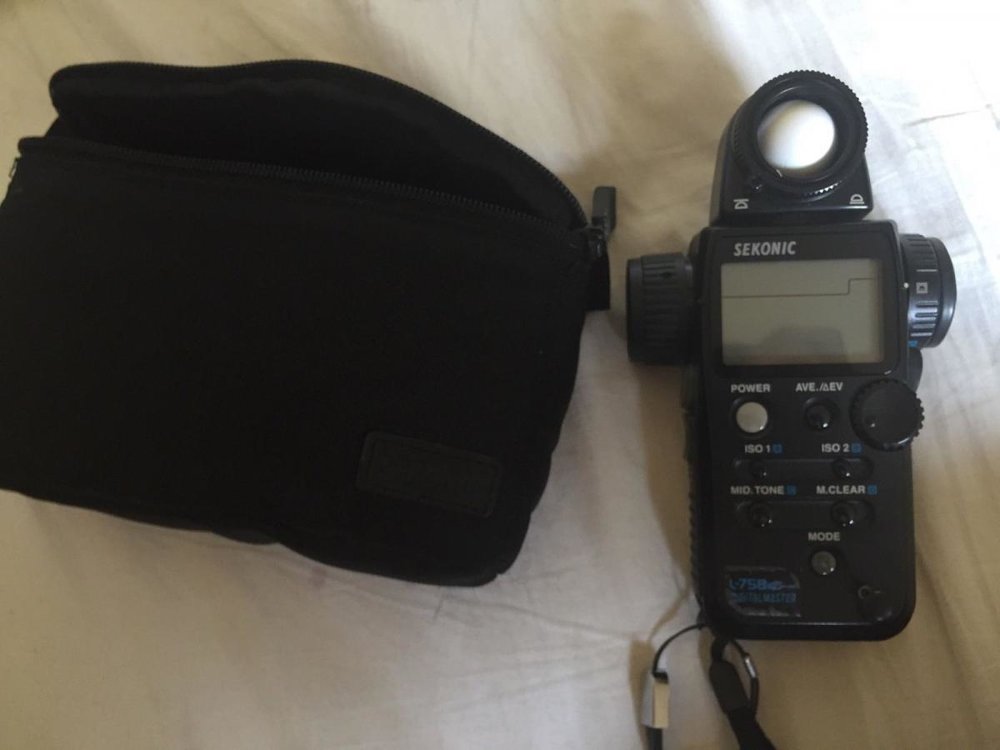Search the Community
Showing results for tags 'sekonic'.
-
HI Simple question (I think): I have a Bolex REX 4. I have a Sekonic L-398A light metre. I use the Cine numbers on the light metre for the reading. But I'm still unsure as to what exposure compensation I should be making from the light reading to the aperture on the camera. Half a stop open? A stop? Thanks for any guidance Jack
-
i'm only asking for help on how to convert the Sekonic color meter "CC" index reading to apply to the Resolve "tint" slider value in the camera RAW section. (no mired/kelvin issues for this.. just the CC value and translating that value for post work) On p12 of the Sekonic manual paraphrased, each CC index number is multiplied by 2.5 to get a Color Correction filter number... OK, that's awesome... for knowing what CC gels to use on lights... ...but how does that meg/grn adjustment number relate to the +/- 150 value in many applications (lightroom/resolve) I would also like to know how to apply that same meg/grn measurement to shots in post too. Here's an example: hypothetical fumbled studio shoot. Tungsten lamps, checked/metered in advance, all good. Power goes out, comes back on an hour later. one of the bulbs is now dead and is replaced. In a rush and don't re-meter lights notice after the talent leaves that something is off with the key (fill bounced) re-meter, yup for some reason the new lamp shows a CC index value of G2 (previous bulb was 0 on the Sekonic C-500) Write down the value... Fast Forward I am now sitting in front of Resolve and looking at the "tint" slider in camera raw window on the "color" tab. what do i set the slider to... +5 -5 +2 -2 .... or something completely different? Please explain in detail. Thank You so much in advance, I have given myself a headache from googling and re-reading manuals =)
-
Hi, I've got an old analogue Sekonic light meter (L-28-C2) and it was working fine earlier this evening when I was testing it outside. I then took it to another location to figure out if I will need filter for the shoot, and when I tried to use it, the needle wouldn't move at all. It is stuck at just below zero foot candles (the lowest possible reading). I know the solar cells in these analogue meters eventually wear out, but one minute it was working and 15 minutes later, nothing. Has my light meter's time come to an end or is there something else that might be wrong with it?
- 5 replies
-
- light meter
- sekonic
-
(and 1 more)
Tagged with:
-
Selling my Sekonic Spectromaster C-700 Spectrometer/Colour Meter. It's in mint condition and very lightly used. Comes with its carry case (and I think I might have the original retail box as well). Located in Melbourne, Australia, but happy to ship worldwide. $1,190 USD / $1,750 AUD + shipping
-
Looking for a used but not abused or good to pristine condition c700 color meter. Should be without issues and complete with box and manuals. Hopefully around 900USD and preferably with a reputable ebay account and can do international shipping as I am Philippine-based. Thanks!
-
https://rover.ebay.com/rover/0/0/0?mpre=https%3A%2F%2Fwww.ebay.co.uk%2Fulk%2Fitm%2F303584655787
-
Perfect conditions! Regular import with box and genuine Sekonic pouch. Asking price is €850 If you don't have an EU or UK VIES enabled VAT ID I have to apply local VAT.
-
- sekonic
- spectrometer
-
(and 9 more)
Tagged with:
-
Sekonic L-608 Super Zoom Master Digital Incident, Spot and Flash Light Meter Priced at: $475.00 Brand New All-In-One Meter Large readable screen Very responsive and very accurate reading Designed for easy operations Zoom Range Built-in parallax-free rectangular 1°- 4° spot zoom with digital display. Combined readings of flash and ambient Percentage of flash in the total exposure Simultaneous display of flash, ambient and combined readings on the analog display Independent incident and reflected exposure compensation of +/-9.9 EV Please text if interested: 760-505-7011
- 2 replies
-
- sekonic
- light meter
-
(and 1 more)
Tagged with:
-
Hello everyone, As I consider buying my first light meter and delve deeper into the world of cinematography, there are a few questions I can't seem to find (satisfying) answers for, at least online. I'd really appreciate any help in these matters. Question 1 Why is it so important to define a camera's true native ISO. Not the marketed one but the actual real one. I've learned how to do it it but I still don't understand why I'd do it. As an example (hypothetical), let's say I'm using an Alexa and I come to the conclusion that its real ISO is 400 instead of the proclaimed 800. What am I supposed to do with that? Should I question the way the stops are supposedly distributed between shadows and highlights? Supposedly at ISO800 it's -7/+7 stops of range, did that range now move to 400? Like what's happening here? Also, does it differ from camera to camera, even if it's the same model? Or can I trust the results from tests done from people I know I trust; whether online or otherwise, for that specific model? I understand we must test, test and test. As a novice I can assure you this notion is drilled into our minds by almost every self respecting cinematographer, gaffer, DIT etc. And I am thankful for it. However can't we trust these manufacturers at least a little bit? Question 2 I took a cinematography workshop not too long ago, my first, and was introduced to light meters and how useful they are. Now that I'm about to work on my first couple of projects I can't imagine myself not using one. However. During that workshop several people had the same light meter (mostly Sekonic 858) and, surprise, not all readings were the same. From the same position on the same spot, whether reading incident light or spotting, people were getting (slightly to not-so-slightly) different readings. So here's my question, how can I tell if I can trust my light meter? I live in a country where most people don't use light meters and we don't have any kind of support to send them off to calibration. Any suggestions? In case it's essential to make sure that the light meter is reading accurately, does anyone know of someone or of a service center that does this anywhere not in the Americas? Also, has anyone ever dealt with Sekonic's service center, the one in Oman? Many thanks. Don't judge me too harshly on my trust issues :)
-
Hi All, I'm shooting a TVC on Sony Venice next week, and have been looking for Sekonic / X-Rite exposure charts for S-log3.cine, preferably in both Native ISO's so that I can load the data into my Sekonic L758-Cine light meter. Does anyone have any good sources for this? Cheers, Lewis Jelley Cinematographer T: +44 (0)2920 251 255 M: +44 (0)7929 174 457 13 Mount Stuart Square, Cardiff, CF10 5EE http://stormandshelter.com Lewis Jelley Cinematographer T: +44 (0)2920 251 255 M: +44 (0)7929 174 457 13 Mount Stuart Square, Cardiff, CF10 5EE http://stormandshelter.com
-
Sekonic L-358 Flash Master Meter - Silver Up for grabs is a *LIKE NEW* Sekonic light meter. I purchased it for $309.00 and have only used it once. Comes with protective pouch, lanyard, extra lens, and new batteries in it! I am looking for $250 (USD), but I am open to reasonable offers. I will cover the PayPal fees, you pay shipping. Willing to do international sale/shipping if you are outside of the US. I've done sales on DVXuser and REDuser and can provide references upon request. I'm also willing to do a video conference to show the product and operation. Please send me a PM if interested. Thanks for your time and interest!
- 4 replies
-
- Sekonic
- Light Meter
-
(and 1 more)
Tagged with:
-
I want to 'upgrade' my Gossen Mastersix to have incident/spot meter all-in-one and am looking at two models (for use in both stills and motion picture FILM and digital use): I'm looking at the Spectra Cine spot meter (the IV with the spot adapter) against the Sekonic 858-D Looking to get experienced user comments as opposed to buying into the marketing they have published....obv the latter is a veery new meter Thanks in advance
- 4 replies
-
- spectra
- light meter
-
(and 1 more)
Tagged with:
-
Hi, I have been using for the past few years been using my Sekonic 508. (not the cine version) and want to upgrade. I am looking at the Sekonic L-478D-U with a 5 Degree Spot Viewfinder adapter and the new Sekonic L-858D-U. Besides having the built in 1-4 degree spot viewfinder what would also be a crucial reasoning to spend the extra $200-300 more for the Sekonic L-858D-U? Would not having the ability to do 1-4 degree spot and be stuck at 5 degrees be a deal breaker? How often do you need the 1-4 degree spot?
- 1 reply
-
- light meter
- sekonic
-
(and 2 more)
Tagged with:
-
Hello everyone, I've been using my light meter for years (Sekonic 558c) and I've been researching as well for a long time and it's been really difficult to find information on how to properly use a light meter. I have tried books, tutorials, skein videos, workshops and even film school but nobody can tell me how they do it. I know light meter gives you certain information and you decide what to do with that. I know light meters and cameras can very a lot and I know how to compensate or calibrate the meter for a certain camera or gamma. I understand 18% gray, and the zone system, incident and reflected meters. But I know that aiming the meter towards the lens is not going to give me the precision that I'm looking for. Here is my example: I'm using a incident meter, I have a person sitting in front of the camera, facing the lens. I have a light source 90 degrees on the right side, easy right? If I aim the meter towards the lens it is going to compensate for the lack of light on the left side, average both sides and it will give me totally not accurate reading. If I point the light meter towards the light source (I guess is the best way to do it) It will give me a reading that is not taking into consideration the shadow on the left side, and it will be "properly exposed". I have done this for some time and I feel like even when my light meter is properly calibrated for the camera it feels a little underexposed. Is Lambert's Cosine rule affecting that light? Because if the light were aligned with the camera angle then I would have a "on the spot" reading. But in reality (the example) I have the light 90· on the side and I'm measuring towards the light. Is the light reflected from the subject affected by Lambert's Cosine rule? Do I have to compensate? I learned from photography class that when they use "Sunny 16" If the sun (light source) is behind you, you don't compensate. If the sun is on your side then you compensate bu half a stop and if the sun is against you the you open up one stop. I have been using this same compensation values with my readings and it had helped me get even better exposures. Why is this important? Well I want to be able to trust my LM and my judgment when lighting a scene, I want to be able to determine "proper exposure" and get consistent results every time so I can take it from there for more artistic interpretations. What do you think? Can you share your experience or even better your technique? Thanks in advance
- 2 replies
-
- light meter
- measuring light
-
(and 2 more)
Tagged with:
-
Hi, I'm new to the forum, so I'm sure that my question -- in typical "noob" fashion -- will be an obvious one; I'll ask it, nonetheless. As a young, aspiring cinematographer, I was recently advised by an experienced DoP to invest in a light meter, which I have done. I've found, however, that my readings will differ between incident and spot; the former tending to have my exposure higher than the latter. I know the difference between incident and reflected light, but am I incorrect to presume that the readings should be the same regardless? Or, am I in fact taking the readings wrongs all together? For spot metering, I will stand where my camera is and aim at the subject's face. For incident metering, I will place the meter in front of the subject, with the lumisphere facing my light source: in the provided example, the light was to the left of the subject's (my mother) face. So, I'm just looking for a bit of feedback regarding my metering techniques. What's the better option? Where should I be aiming the lumisphere when taking a reading? Where should I be aiming the spot? Thank you in advanced, Thomas.
-
- 1 reply
-
- equipment
- lightmaster
- (and 7 more)
-
I wanted to know if I should invest in a lighter meter with a 1 degree spot meter or will a 5 degree spot meter do just fine? I'm planning to purchase the Sekonic L-478DR or the L-758cine depending on what feed back I get through this community. I'm new to this field of work and currently a student so I want something for long term and I don't want to be in a situation where I need to purchase a 1% spot meter. Thanks.
- 5 replies
-
- sekonic
- lighter meter
-
(and 1 more)
Tagged with:
-
Hi, I've just got my hands on this light meter for the first time and can't for the life of me work out how to put it in Cine mode so I can set fps. The Sekonic is not doing what I expect after reading the manual. I've been through every mode (by holding the mode button down and turning the set/change dial) and none provide a fps display as shown in the manual on page 16? Can anyone help? I guess it's something too obvious for me! Thanks
-

FS: Sekonic Light Meter L-718 Digi Master with Lumidisc
T Sanders posted a topic in Cine Marketplace
I'm selling this Sekonic light meter for $75. Ebay Listing: http://www.ebay.com/itm/171360860979 DOES NOT COME WITH THE DOME. A multi-function digital ambient flash meter for the working pro on location or in the studio. Features 1/10 step digital and 1/2 step analog readout, multi-directional dual pivot light receptor, memory functions, and rubberized covering. Optional 5° spot and ground glass reading receptor. This light meter is in good working condition and comes with the strap and pouch. *This light meter does not come with the white dome but does come with the lumidisc. The dome is no longer available for purchase and there is no alternative replacement. Also comes with: Sekonic Lumidisc for L-718 Exposure Meter #401-828 DOES NOT COME WITH THE DOME.- 1 reply
-
- light meter
- lightmeter
-
(and 1 more)
Tagged with:
-
Hey guys, just wondering what do you think about sekonic l-478d?
- 1 reply
-
- Sekonic
- lightmeter
-
(and 1 more)
Tagged with:
-
Hey all, I'm a film student and i just bought a used sekonic light meter 758d. I wanted to match it with the red scarlet i'm usually using for shooting. So i set up a 18% greycard and used false colors in Redcolor3 view to match the mid grey (green color on the card). Camera was set to 640 ISO, 25 fps, 1/50, f8. After i took a reflective reading with my sekonic i found that i should set it to 320 ISO, 25fps, 180 degree, to match the f8. Anyway after turning false colors off i found the image of the greycard way darker than i expected. I also tryed to expose a skin tone on the same lighting setup (on f 5,6 to get it properly exposed) and still seemed a bit underexposed. Then i decided to try matching the light meter in Raw view. After i got green on the card with false colours turned on i swithced back to Redcolor and i had much better feeling with the image. So my first question is, am i doing something wrong to match my sekonic or is there a better or more acurate way to do it ? Second, should i match it in raw view or redcolor3 when considering, that the clipping and crashing levels are the same in both modes ? Sry for my english :)
- 8 replies
-
- sekonic
- light meter
-
(and 2 more)
Tagged with:




